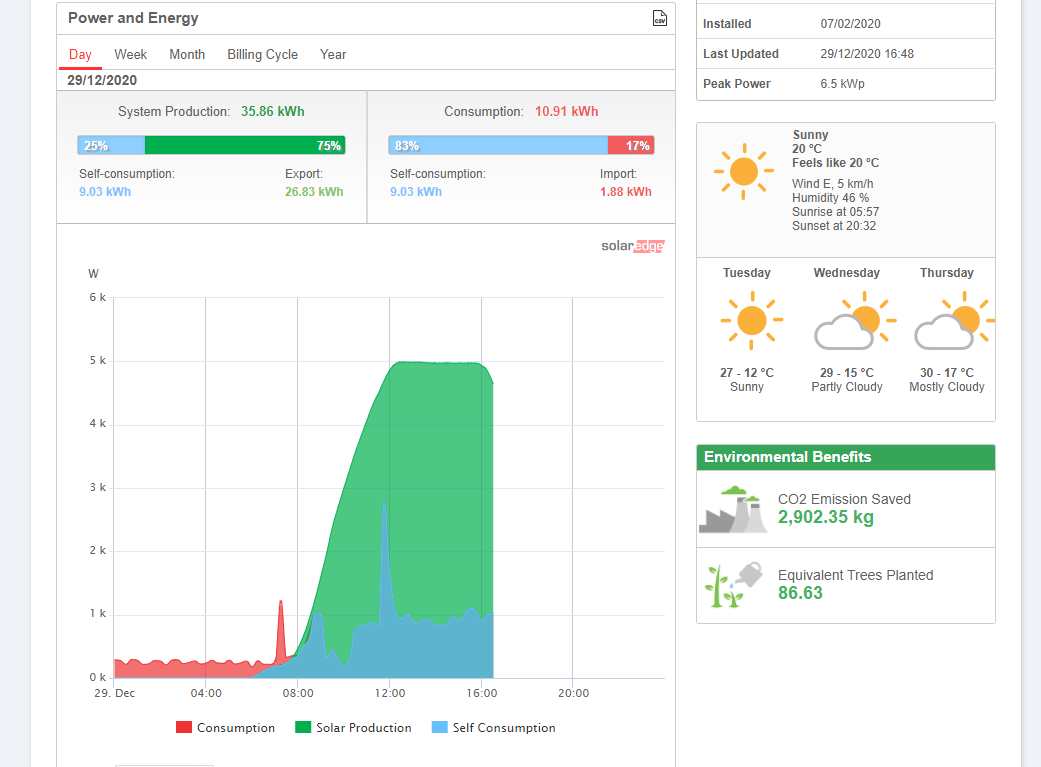
Today is a brilliant day. It’s a gorgeous summer day in Wodonga, Victoria and with the sun shining, our 6.5kW solar system is collecting a hard 5kW of power, limited by the SolarEdge inverter (and restrictions by the energy distributor).
When spilling power like this, it’d be the perfect opportunity to run the washing machine, turn on the dishwasher or charge your electric car. Power drawn using in the house during these times, is essentially for free.
Free power is usually thought of when you’re not paying for it, like most of the day, once you have solar, however that does reduce the credit you earn via a Feed-in-tarrif, for feeding power back to the grid, so it’s not a cost, but a lost opportunity.
We can see and monitor this energy usage via our phone or the web, thanks to today’s modern, internet connected solar inverters.
In an ideal world, we could have our connected cars, talking to our connected home and start charging when the power is free, like the situation I mentioned above.
While a car like Tesla’s Model 3 has a sim card in, it also connects to your home WiFi (for updates etc). If Tesla were to enable an API, developers could write an interface that connects to your solar system (SolarEdge already have an API), that could know when it’s free to send power to the car.








Currently the only options for charging in the car are for ‘Scheduled Departure’ and Scheduled Charging’.
The first of these options works by ensuring you have the required charge by a specific time, like 7am, ready for your morning commute to work, and does the charging during off-peak hours. This means you get home at 6pm, plug in your car, but charging doesn’t start during those expensive afternoon/evening hours, but can be configured to charge at the lowest possible off-peak rates.
The second option is Scheduled Charging, which is a very basic, time of day scheduler, with the option to select all days or just weekdays. Given the variety in sun behaviour, this doesn’t really work when trying to achieve the charging for free scenario I mentioned above.
Through an API, the car could talk to the inverter and know when the maximum feed-in rate has been achieved, while still having an excess of power being collected by the panels.


With a 6.5kW system, it will never be 100% efficient, but during the peak of the day, I maybe could get 6kW from it, meaning I could get close to 1kW of charging for free, or alternatively have options of how much of my feed-in-tarrif I’m willing to eat into.
When charging, the charging the Model 3 consumes just under 2kW of energy. With the rest of my house using right around 1kW per hour during the day, there’s plenty of room to play with.
From a standard 240v outlet, the car can gain an extra 11km of range per hour. That means in just 4 hours the car would have returned more than the average use of around 40km per day.
For this level of flexibility to be achieved Tesla, and other connected car manufactures would need to enable charging APIs that integrate with solar inverters. Right now the two big names in the space are SolarEdge and Fronius, both of which have existing APIs.


Of course there are lots of options on the table once our connected cars starting opening up to 3rd parties. Imagine being on a road trip and ordering food from McDonalds or KFC through the display in your car. This could ask you to register your number plate, then when you arrive at store, there’d be no discussion of order numbers etc, you simply drive through, collect your meal, having already paid via your Tesla account.
I’d love to hear your thoughts in the comments below.

Thought about getting a Zappi?